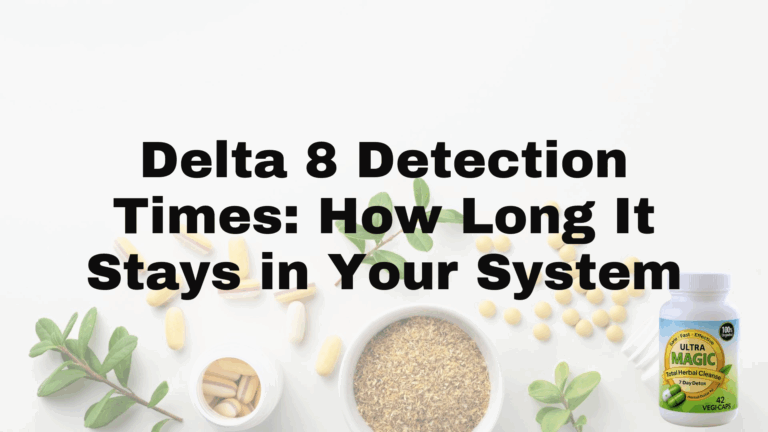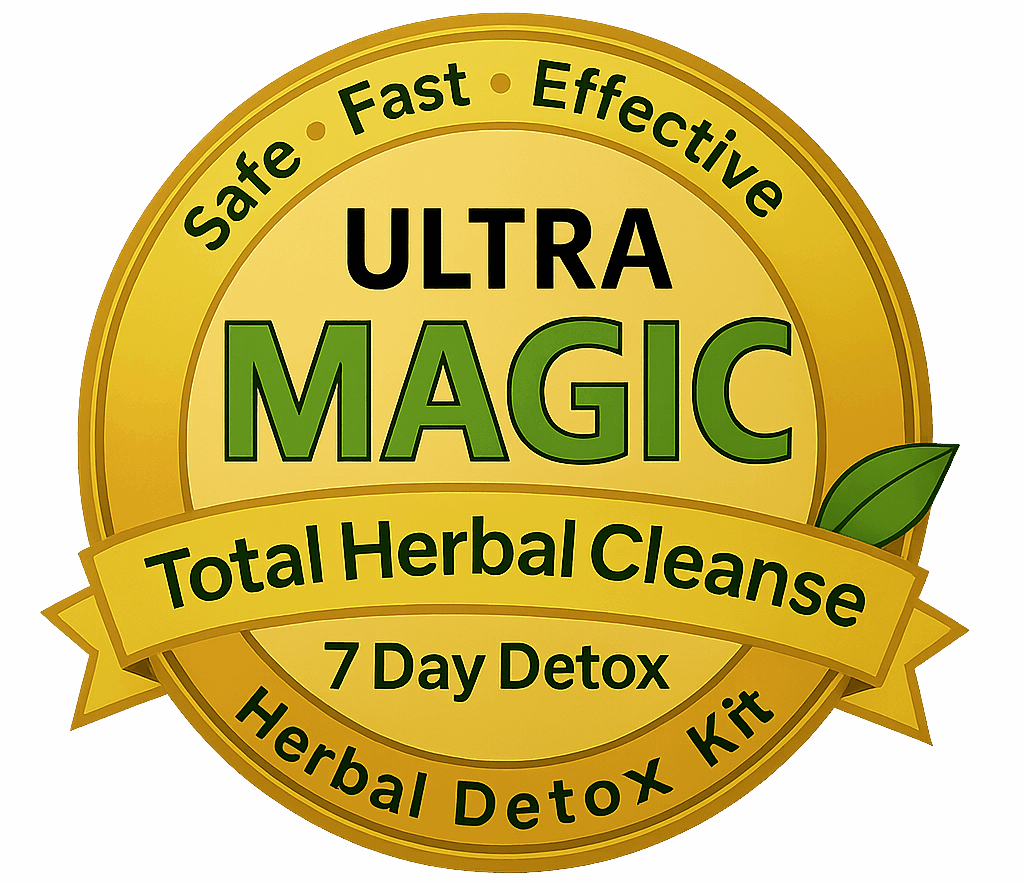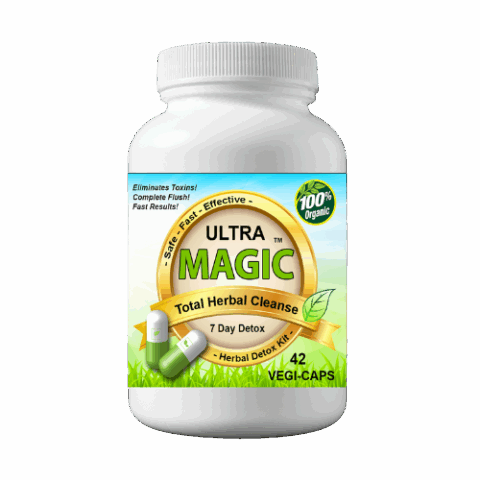
Delta 8 Detection Times: How Long It Stays in Your System
Delta-8 THC is a hemp-derived cannabinoid with a milder high. Drug tests don’t look for “delta-8” itself—they measure THC metabolites, mainly THC-COOH. Because delta-8 breaks down into the same metabolites as delta-9 (marijuana) THC, it can still trigger a positive. “How long it stays in your system” means how long those metabolites are detectable: roughly hours to a day or two in blood or saliva, days to weeks in urine, and up to about 90 days in hair.
This guide delivers evidence-based detection windows by test type and usage pattern, the factors that shorten or stretch them (dose, frequency, body fat, metabolism, product form), what can and can’t speed elimination, and myths to skip. You’ll also get clear, realistic planning tips for upcoming tests, key health/employment/legal notes, and where a full-body detox may fit. First up: how your body processes delta-8—and why that matters.
How delta-8 THC is metabolized and why that matters for drug tests
After you consume delta-8, your liver converts it into active 11-hydroxy-THC and then into THC-COOH. Labs don’t test for “delta-8” or “delta-9” themselves—they screen for these downstream metabolites, especially THC-COOH. Because delta-8 and delta-9 yield the same THC-COOH, standard tests flag them identically. THC and its metabolites are lipophilic, so they distribute into fat and can leach back into circulation over time, which is why urine detection stretches from days to weeks in frequent users, and hair tests can reflect use for months.
- Same metabolite, same result: Delta-8 and delta-9 both become THC-COOH, so most tests can’t tell them apart.
- Fat storage extends windows: Cannabinoid metabolites linger longer with frequent use and higher body fat; some people remain positive for weeks.
- Route matters: Edibles undergo first-pass metabolism, producing more metabolites and potentially longer detection than smoking or vaping.
- Matrix differences: Parent compounds fade quickly in blood/saliva (hours to a couple days), while urine (days to weeks) and hair (up to ~90 days) capture longer windows.
Factors that change how long delta-8 stays in your system
Two people can take the same delta-8 gummy and show very different timelines. That’s because how long delta 8 stays in your system is shaped by your pattern of use, body composition, how you consume it, and the kind of test you face. THC metabolites are fat-soluble and build up with repetition, so small differences in routine can add up to big differences in detection.
- Frequency of use: Daily or near-daily use saturates fat stores, extending urine detection from days into weeks compared with one-time use.
- Dose and potency: Larger doses and stronger products create more metabolites, lengthening detection windows.
- Body fat and weight change: Higher body fat stores more THC; rapid weight loss or intense exercise can briefly release stored THC before levels decline.
- Metabolism and activity: Faster metabolisms and active lifestyles may shorten windows slightly, though fat storage still dominates.
- Consumption method: Edibles (gummies, tinctures) undergo first-pass liver metabolism, often producing more metabolites and longer detection than smoking or vaping.
- Hydration and diet: Helpful for general wellness, but only modestly affect elimination speed.
- Test type and cutoff: Saliva/blood capture recent use (hours to ~2 days); urine and hair reflect longer windows and can detect lower levels depending on cutoffs.
How long delta-8 is detectable on urine tests
Urine tests are the most common screen for THC, and they look for the metabolite THC-COOH. Because delta-8 and delta-9 break down into the same metabolite, delta-8 use will register the same way as marijuana on a standard urine panel. How long delta 8 stays in your system on urine tests depends on your usage frequency, dose/potency, body fat, metabolism, and product type. Multiple medical sources place regular use around 10–15 days and heavy use up to 30 days. The ranges below reflect typical windows.
| Usage pattern | Typical urine detection window* |
|---|---|
| One-time / occasional | Up to 3 days |
| Moderate (few times per week) | About 5–7 days |
| Regular / daily | Roughly 10–15 days |
| Heavy / chronic or higher body fat | Up to 30 days |
Edibles and tinctures undergo first-pass metabolism, creating more THC-COOH than smoking or vaping, so they often push results toward the longer end of each range. Hydration, clean diet, and activity support normal clearance but rarely shift timelines dramatically. If you’re a frequent or heavy user—especially with higher body fat—plan for the possibility of a positive for two weeks or more, with some individuals remaining detectable near 30 days. Cutoffs and lab methods vary; more sensitive panels can extend windows slightly.
Typical windows; individual results vary.
How long delta-8 is detectable on saliva tests
Oral-fluid (saliva) tests are designed to spot very recent THC exposure. Because delta-8 yields the same THC signature, the timelines mirror marijuana. For most people, how long delta 8 stays in your system on saliva tests is short: typically within hours after use and clearing in about 24 hours for one-time use, extending to roughly 48 hours with frequent or higher-dose patterns. Employers and roadside screens favor saliva because it captures current impairment risk more than past use; it does not generally reach back weeks like urine or hair.
| Usage pattern | Typical saliva detection window |
|---|---|
| One-time/occasional | Up to ~24 hours |
| Frequent/daily | Up to ~48 hours |
Typical windows; individual results vary.
How long delta-8 is detectable on blood tests
Blood tests assess recent use by measuring parent THC and active metabolites like 11‑hydroxy‑THC. Because delta‑8 converts to the same analytes as delta‑9, it’s indistinguishable on a standard panel. For most people, how long delta 8 stays in your system on blood tests is short—typically a few hours to about a couple of days—with edibles sometimes nudging results toward the upper end. Blood testing is common after accidents, DUIs, or when recent impairment matters, not for long look‑back windows like urine or hair.
| Usage pattern | Typical blood detection window |
|---|---|
| One-time/occasional | Several hours up to ~24 hours |
| Frequent/daily | Up to ~48 hours (sometimes a bit longer) |
Cutoffs and lab methods vary, but even sensitive blood assays generally remain in the “hours to days” range rather than weeks.
How long delta-8 is detectable on hair tests
Hair testing captures the longest look-back window because labs analyze metabolites embedded in the hair shaft over time. Since delta‑8 and delta‑9 produce the same THC metabolites, hair tests cannot distinguish between them. For most standard panels, how long delta 8 stays in your system on hair tests is up to about 90 days. These tests are used less often than urine screens and can be influenced by factors like hair characteristics or cosmetic treatments, so results may vary.
| Hair testing | Typical detection window |
|---|---|
| Standard lab panel | Up to ~90 days |
Typical windows; individual results vary.
Detection timelines by usage frequency and dose
If you’re trying to predict how long delta 8 stays in your system, start with frequency and dose. The more often and the more you use, the more THC-COOH accumulates in fat stores, extending detection—especially on urine and hair tests. Cutoffs and lab methods matter, but the ranges below reflect what multiple medical sources report for most people.
| Usage pattern | Saliva | Blood | Urine | Hair* |
|---|---|---|---|---|
| One-time/occasional | Up to ~24 hours | Hours to ~24 hours | Up to ~3 days | Up to ~90 days |
| Moderate (2–4x/week) | ~24–36 hours | ~24 hours | ~5–7 days | Up to ~90 days |
| Regular/daily | Up to ~48 hours | Up to ~48 hours | ~10–15 days | Up to ~90 days |
| Heavy/chronic or higher body fat | Up to ~48 hours | ~48 hours (sometimes slightly longer) | Up to ~30 days | Up to ~90 days |
Typical ranges; individual results vary.
*Hair reflects a long look‑back window and is more likely to detect repeated use within the ~90‑day growth period.
Higher doses and stronger products push you toward the longer end of each range, while longer abstinence, lower body fat, and time help reduce it. Next, see how product type (gummies vs vapes vs tinctures vs flower) can shift these timelines.
Does product type affect detection time? gummies, vapes, tinctures, flower
Yes—product type can shift detection time, but dose and frequency matter most. If you’re asking how long does delta 8 stay in your system, form can nudge the window rather than define it. Edibles (gummies) and swallowed tinctures go through first-pass liver metabolism, generating more active metabolites and pushing urine results toward the longer end of typical ranges. Inhaled forms (vapes, flower) deliver faster onset and may clear a bit sooner. Sublingual tinctures often land between inhalation and edibles.
- Gummies/edibles: More metabolites; longer end of range.
- Vapes/flower: Shorter end if dose is modest.
- Tinctures: Swallowed ≈ edibles; sublingual in-between.
For hair testing, repeated exposure dwarfs format. And no test sees “product type”—they detect metabolites, setting up the next section.
Delta-8 vs delta-9 on drug tests: what labs actually measure
When a lab screens for cannabis, it doesn’t look for the exact THC isomer you used. It measures THC breakdown products. Both delta‑8 and delta‑9 are metabolized into the same primary metabolite, THC‑COOH, which urine tests are designed to detect. Blood and saliva panels focus on recent use by measuring THC and immediate metabolites, and hair testing captures metabolites incorporated into the hair shaft. Because the analytes overlap, standard drug tests can’t distinguish delta‑8 from delta‑9, which is why “how long does delta 8 stay in your system” largely mirrors marijuana timelines.
- No delta‑8 loophole: A positive is reported as THC, not the isomer.
- Labels don’t matter: “Hemp‑derived” or “<0.3% delta‑9” won’t change detection.
- Form shifts, not identity: Edibles may extend windows, but results still read THC.
- Time is decisive: Only abstinence and time lower metabolites below a test’s threshold.
How long the effects last vs how long tests detect it
Delta‑8’s effects wear off long before tests stop seeing it. Inhaled delta‑8 (vapes/flower) is usually noticeable for a few hours, while edibles like gummies can last about 4–8 hours or more. Yet drug tests track metabolites that linger after the high: blood and saliva typically detect use for hours to roughly 1–2 days, urine can stay positive for days to weeks depending on frequency (up to ~30 days in heavy users), and hair can reflect use for about 90 days. Feeling “sober” isn’t the same as testing negative—if you’re asking how long does delta 8 stay in your system, remember detection outlasts effects.
What can and can’t speed up elimination: evidence-based guidance
If your test date is looming, the honest answer is that time and abstinence do almost all the work. Delta‑8’s primary metabolite (THC‑COOH) is stored in fat and clears gradually; you can support normal elimination, but you can’t compress weeks into hours. Most medical sources agree that hydration, healthy diet, and regular activity have only modest effects, while the single most reliable lever for how long delta 8 stays in your system is stopping use as early as possible.
- Stop immediately: Every day of abstinence lowers future metabolite levels.
- Hydrate sensibly: Aim for pale-yellow urine; avoid excessive chugging.
- Train smart: Light-to-moderate exercise over weeks can help; avoid all‑out workouts 24–48 hours before testing, which can mobilize stored THC.
- Eat regularly with fiber: Stable meals support liver/renal clearance; skip crash diets or fasting that can release fat‑stored THC.
- Prioritize sleep: Rest supports metabolic and endocrine balance tied to clearance.
- Choose format wisely (if not abstinent): Edibles create more metabolites than inhaled forms—still, only abstinence reliably shortens detection.
What generally doesn’t move the needle: last‑minute “flushes,” extreme sweating, or overhydration. Labs check dilution markers (like creatinine/specific gravity), so masking strategies often backfire. Next, here are the myths and risky hacks to avoid.
Common myths and risky “detox hacks” to avoid
When the clock is ticking, it’s tempting to reach for a quick fix. Be careful: most “detox hacks” don’t eliminate delta‑8 metabolites and can get you flagged—or harm your health. Multiple medical sources caution that manipulation attempts rarely work and may be dangerous.
- Detox drinks/teas: Mask, don’t remove; labs flag low creatinine/specific gravity.
- Niacin/vitamin megadoses: No proof; risk flushing, GI or liver issues.
- Overhydration: Unsafe and often returns “dilute” or invalid samples.
- Last‑minute saunas/HIIT/fat burners: May mobilize fat‑stored THC and backfire.
- Adulterants/synthetic urine/substitution: Often illegal, detectable, and career‑ending if caught.
- Home remedies (vinegar, cranberry, baking soda, charcoal): No reliable reduction in detection windows.
Planning if you have an upcoming test: realistic expectations and safer choices
If your test is on the calendar, build your plan around time, abstinence, and the test type. Saliva and blood generally detect use for hours to about 1–2 days; urine ranges from up to 3 days after one-time use to roughly 10–15 days with regular use, and can stretch to about 30 days in heavy users or those with higher body fat; hair can reflect use for around 90 days. Use these realities to set expectations—and avoid last‑minute mistakes.
- Stop now: Every day off lowers future metabolite levels.
- Confirm details: Ask which test (urine, saliva, blood, hair), the date, and whether rescheduling is allowed.
- 0–48 hours out: Abstain, hydrate normally, skip extreme workouts; expect saliva/blood risk in this window.
- 3–7 days out: Abstain, keep hydration and meals steady, favor light activity, avoid crash diets; consider an at‑home urine test to gauge progress.
- 8–15 days out: Daily users may still be positive on urine; request a delay if possible and keep routines steady (no fasting/overtraining).
- 16–30 days out: Heavy or higher‑body‑fat users can still test positive; stay patient and consistent.
- Hair testing: No short‑term tactic overcomes ~90‑day look‑back; abstinence and time are the only levers.
- Don’t gamble: Skip “detox hacks,” dilution, or adulteration—labs check for those and it can backfire.
If employment, health, or legal stakes are high, proactive planning matters—understand the rules you’re operating under and protect yourself accordingly.
Health, employment, and legal considerations to know
Health, employment, and legal stakes hinge on one reality: standard drug tests report THC, not the isomer. So even if delta‑8 is hemp‑derived or legal in your state, a positive reads the same as marijuana. Add that delta‑8’s safety is incompletely understood and side effects are real, and you’ve got reasons to plan carefully—especially where jobs, licenses, probation, or benefits are on the line.
- No testing distinction: A THC positive is a THC positive.
- Workplace policies: Many employers treat any THC positive as a violation.
- State laws vary: Confirm local rules; delta‑8 legality differs by state.
- Health and safety: It’s psychoactive—avoid driving or hazardous work while affected.
- Dependence risk: Some develop problematic use; seek clinical or treatment support.
- Tampering backfires: Dilution/adulteration is often detected and can add penalties.
Where a full-body detox fits in your plan
If you’re abstaining ahead of a test, a full‑body detox can give structure to the crucial week when it matters most. It won’t change how long delta‑8 stays in your system overnight, but it can support hydration, regularity, and liver/kidney function while you let time work. Ultra Magic Detox is a 7‑day, maximum‑strength herbal cleanse made in a GMP, FDA‑registered facility in Florida, using non‑GMO, lab‑tested botanicals like burdock, dandelion, rhubarb, goldenseal, sheep sorrel, cat’s claw, and pau d’arco—suitable even for heavy users. Use it to anchor a clean‑break week, not as a same‑day loophole: hair’s ~90‑day window and heavy users’ urine timelines still apply. In short, a structured detox helps you feel better and stay consistent while metabolites decline, but time and abstinence do most of the work.
Bottom line on delta-8 detection
Bottom line: delta‑8 becomes the same THC‑COOH labs measure for marijuana, so there’s no testing loophole. Saliva and blood usually detect it for hours to ~1–2 days; urine for up to 3 days (one‑time), ~5–7 days (moderate), ~10–15 days (regular), and up to ~30 days (heavy); hair about 90 days. Edibles can lengthen windows. Frequency, dose, body fat, and test cutoffs drive results. The high ends fast; detection doesn’t. Time and abstinence matter most.
If a test is coming, stop now, keep routines steady, and skip risky “detox hacks.” To anchor a clean‑break week while you abstain, use a structured full‑body detox to support hydration, regularity, and consistency—not as a same‑day workaround. Learn more at Magic Detox.



